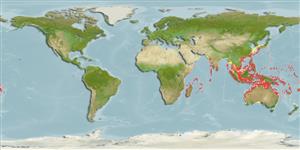Actinopterygii (ray-finned fishes) >
Scorpaeniformes (Scorpionfishes and flatheads) >
Tetrarogidae (Wasp fishes)
Etymology: Paracentropogon: Greek, para = the side of + Greek,kentron = sting + Greek, pogon = beard (Ref. 45335).
Environment / Climate / Range
Ecology
Marine; demersal; depth range ? - 70 m (Ref. 39597). Tropical, preferred ?
Indo-West Pacific: southern India to southern China and New Caledonia.
Size / Weight / Age
Maturity: Lm ? range ? - ? cm
Max length : 13.0 cm TL male/unsexed; (Ref. 48635)
Dorsal
spines
(total): 12 - 15;
Dorsal
soft rays
(total): 7-8;
Anal
spines: 2;
Anal
soft rays: 5. Geographical differences: specimens from the Gulf of Thailand usually with large blotches over the body; those from Indonesia and Australia generally have less solid markings. Species observed to alter its color from light to dark in captivity. Scales in vertical rows, 44-66 (Ref. 39597).
Found inshore on and around corals and hard bottoms (Ref. 39597), silty and muddy habitats (Ref. 48635). Often taken by nets and handlines (Ref. 39597). Also found in rocky bottoms and coral reef crevices in about 7-70 m (Ref 90102).
Life cycle and mating behavior
Maturity | Reproduction | Spawning | Eggs | Fecundity | Larvae
Paxton, J.R., D.F. Hoese, G.R. Allen and J.E. Hanley, 1989. Pisces. Petromyzontidae to Carangidae. Zoological Catalogue of Australia, Vol. 7. Australian Government Publishing Service, Canberra, 665 p. (Ref. 7300)
IUCN Red List Status (Ref. 115185)
CITES (Ref. 94142)
Not Evaluated
Human uses
Fisheries: of no interest; aquarium: commercial
More information
Common namesSynonymsMetabolismPredatorsEcotoxicologyReproductionMaturitySpawningFecundityEggsEgg development
ReferencesAquacultureAquaculture profileStrainsGeneticsAllele frequenciesHeritabilityDiseasesProcessingMass conversion
Tools
Special reports
Download XML
Internet sources
